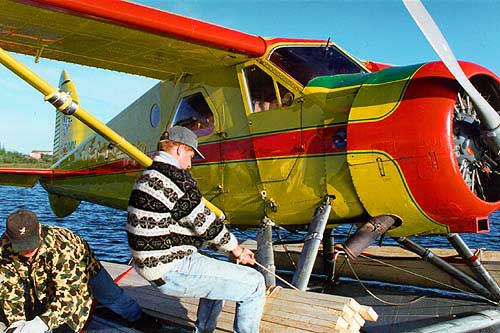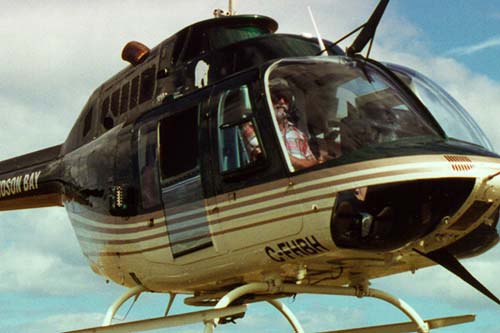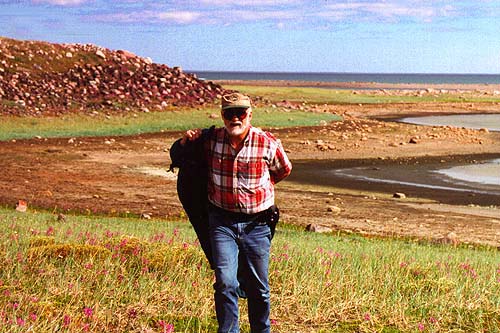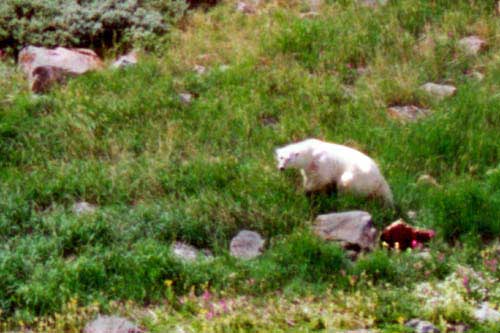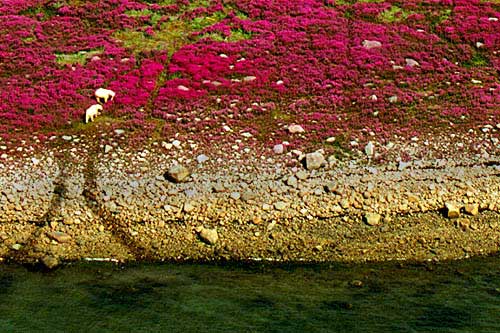![]() Hudson Bay Helicopters:
Hudson Bay Helicopters:
![]() Part One
Part One
Polar Bears in a Purple Patch
![]()
![]() Steve Miller was late.
Steve Miller was late.
"That's not like Steve," says Doug Webber. "He's usually early."
![]() As we waited I talked to a
group of canoers who had just been flown in on Doug's Beaver after
paddling the Seal River. They were unanimous in their appraisal of the
trip they had just completed. They loved it and would do it again. That is
strong praise from dirty hungry and sore paddlers who had just come in
from the cold and bugs. The young men and women were still craving their
first "Coffee Crisp" chocolate bar to be followed by a McDonald's
hamburger. The burger was still a long way off considering that the
nearest franchise was 600 miles south. Instead they settled for
licking the powder contents of "instant blueberry muffins." I
envied the young travellers as I could not remember when I had been so
hungry or desperate.
As we waited I talked to a
group of canoers who had just been flown in on Doug's Beaver after
paddling the Seal River. They were unanimous in their appraisal of the
trip they had just completed. They loved it and would do it again. That is
strong praise from dirty hungry and sore paddlers who had just come in
from the cold and bugs. The young men and women were still craving their
first "Coffee Crisp" chocolate bar to be followed by a McDonald's
hamburger. The burger was still a long way off considering that the
nearest franchise was 600 miles south. Instead they settled for
licking the powder contents of "instant blueberry muffins." I
envied the young travellers as I could not remember when I had been so
hungry or desperate.
![]() Their comments were even
more encouraging considering we were waiting for Steve to take us up to
the Seal River Heritage Lodge. There was a big difference in our mode of
travel and also the landscape of our journey. They came down the river
slowly. Very slowly. And they stopped short of the coast. A good thing
that as the polar bears don't often go far inland here. Most of the bears
are up north now, but these are the summer bears. They mostly hang around
the coast avoiding the worst of the bugs and generally not eating all
summer. Still,
the bears are a concern for canoers sleeping in tents. And I have my
personal doubts about the "no eating in summer" theory. What
bear could resist a canoer fattened on blueberry muffin powder?
Their comments were even
more encouraging considering we were waiting for Steve to take us up to
the Seal River Heritage Lodge. There was a big difference in our mode of
travel and also the landscape of our journey. They came down the river
slowly. Very slowly. And they stopped short of the coast. A good thing
that as the polar bears don't often go far inland here. Most of the bears
are up north now, but these are the summer bears. They mostly hang around
the coast avoiding the worst of the bugs and generally not eating all
summer. Still,
the bears are a concern for canoers sleeping in tents. And I have my
personal doubts about the "no eating in summer" theory. What
bear could resist a canoer fattened on blueberry muffin powder?
![]() Moreover, we will be flying up
the coast in a helicopter. Much quicker than paddling, but still slow and
low enough to enjoy the coastal scenery. Plus, we get to see the world
from the advantage of height. In this flat but undulating landscape of the
sub-arctic tundra you could possibly see a polar bear from miles away.
From the perspective of the ground bound, however, the bear could be
sleeping on the grass in a little meadow just over the next ridge and you
would not see him until you were right there. From above you will find him
before he finds you.
Moreover, we will be flying up
the coast in a helicopter. Much quicker than paddling, but still slow and
low enough to enjoy the coastal scenery. Plus, we get to see the world
from the advantage of height. In this flat but undulating landscape of the
sub-arctic tundra you could possibly see a polar bear from miles away.
From the perspective of the ground bound, however, the bear could be
sleeping on the grass in a little meadow just over the next ridge and you
would not see him until you were right there. From above you will find him
before he finds you.
![]() One of
the young canoers, ears tuned from weeks of silence, says he hears a
helicopter. The helicopter appears from the direction of Churchill
town. I anticipate meeting Steve the pilot. He introduces himself with
his flying. His approach is a well written poem or sea-fog flowing on wings.
Steve circles in like an arctic tern and pounches like a robber fly. He makes the transition in the
JetRanger from slow flight to the hover as graceful as a sandhill crane
flapping his wings during a mating dance. Steve Miller can fly that machine.
One of
the young canoers, ears tuned from weeks of silence, says he hears a
helicopter. The helicopter appears from the direction of Churchill
town. I anticipate meeting Steve the pilot. He introduces himself with
his flying. His approach is a well written poem or sea-fog flowing on wings.
Steve circles in like an arctic tern and pounches like a robber fly. He makes the transition in the
JetRanger from slow flight to the hover as graceful as a sandhill crane
flapping his wings during a mating dance. Steve Miller can fly that machine.
![]() There is something I've
noticed about helicopter pilots. Something in their environmental
circumstances insures that the eldest take the best and most interesting
jobs. While Doug Webber's Beaver pilot was a young guy with little actual
flying experience, Steve Miller is the archetype of helicopter pilots.
Steve, when he does show, flying in low over the horizon, is a white
haired white bearded well tanned wind burnt grizzled pilot of local
renown.
There is something I've
noticed about helicopter pilots. Something in their environmental
circumstances insures that the eldest take the best and most interesting
jobs. While Doug Webber's Beaver pilot was a young guy with little actual
flying experience, Steve Miller is the archetype of helicopter pilots.
Steve, when he does show, flying in low over the horizon, is a white
haired white bearded well tanned wind burnt grizzled pilot of local
renown.
![]() "Sorry,
I'm late."
He exclaims. "Busy day. Are you ready?" Steve is indeed busy. He
has established himself and his two helicopters as the only full time year
round operator in the Churchill area. You don't mind waiting a few minutes
for him, mostly because during this time of the season the other operators
are off somewhere else, and you couldn't get them if you wanted. Steve
stays to take care of his people. He may not get as much contract work by
staying in one area, but he hopes that his dedication and loyalty to his
Churchill customers will pay off in the long run. We appreciate the fact
that both him and his helicopter are available to take us North.
"Sorry,
I'm late."
He exclaims. "Busy day. Are you ready?" Steve is indeed busy. He
has established himself and his two helicopters as the only full time year
round operator in the Churchill area. You don't mind waiting a few minutes
for him, mostly because during this time of the season the other operators
are off somewhere else, and you couldn't get them if you wanted. Steve
stays to take care of his people. He may not get as much contract work by
staying in one area, but he hopes that his dedication and loyalty to his
Churchill customers will pay off in the long run. We appreciate the fact
that both him and his helicopter are available to take us North.
![]() His beautiful new forest
green Bell 206 JetRanger 3 is equipped with two photographic windows and
full intercom, to make the best of the guaranteed photo opportunities that
will come our way. I sit up front to get to know Steve better, and let a
film maker and a photographer have the two scenic windows. They are full
of dumb questions which Steve answers good-naturedly. Steve has this
santa-claus smile and a perpetual twinkle in his arctic weathered eyes
that immediately puts you at ease with the upcoming flight whether you are
scared of flying or not. You just know whatever happens he can handle it.
His beautiful new forest
green Bell 206 JetRanger 3 is equipped with two photographic windows and
full intercom, to make the best of the guaranteed photo opportunities that
will come our way. I sit up front to get to know Steve better, and let a
film maker and a photographer have the two scenic windows. They are full
of dumb questions which Steve answers good-naturedly. Steve has this
santa-claus smile and a perpetual twinkle in his arctic weathered eyes
that immediately puts you at ease with the upcoming flight whether you are
scared of flying or not. You just know whatever happens he can handle it.
![]() We finish loading and Steve
fires up the Allison turbine with the soul lifting smell of burning Jet
Fuel - my favorite smell next to fresh baked bread. (Only a
turbine-spoiled bush pilot could understand that preference.) Within
minutes we lift off Landing Lake waters like an arctic skimmer
searching for herring with the bushes and reeds parting beneath us from
the downward rotor wash. Slowly we gain altitude turning north bound to
view the Churchill Port and the mouth of the Churchill River. Steve points
out the pods of Beluga whales heading out of the river with the outgoing
tide. "Not many here, compared to where we are going," he quips
over the intercom. "Wait until we get to the Seal River, that is
where we will see whales."
We finish loading and Steve
fires up the Allison turbine with the soul lifting smell of burning Jet
Fuel - my favorite smell next to fresh baked bread. (Only a
turbine-spoiled bush pilot could understand that preference.) Within
minutes we lift off Landing Lake waters like an arctic skimmer
searching for herring with the bushes and reeds parting beneath us from
the downward rotor wash. Slowly we gain altitude turning north bound to
view the Churchill Port and the mouth of the Churchill River. Steve points
out the pods of Beluga whales heading out of the river with the outgoing
tide. "Not many here, compared to where we are going," he quips
over the intercom. "Wait until we get to the Seal River, that is
where we will see whales."
![]() The JetRanger settles in to
about 200 feet above seal level. The sky is blue and the visibility is
virtually unlimited. Severe clear. I can distinctly see 360 degrees of
horizon surrounding us. As we reach one horizon there is always another.
Horizons. Not one but many. "Polar bear," Steve whispers over
the intercom to me. I strain forward to see better. I see a huge white
rock looking menacingly like a white bear. I wait for Steve. Maybe he sees
something I don't.
The JetRanger settles in to
about 200 feet above seal level. The sky is blue and the visibility is
virtually unlimited. Severe clear. I can distinctly see 360 degrees of
horizon surrounding us. As we reach one horizon there is always another.
Horizons. Not one but many. "Polar bear," Steve whispers over
the intercom to me. I strain forward to see better. I see a huge white
rock looking menacingly like a white bear. I wait for Steve. Maybe he sees
something I don't.
![]() Shortly after Steve
acknowledges the bear-like rock. I know how he feels. I continuously point
out large white cap waves as breaching whales to my passengers in West
Africa. I don't get embarrassed, however, and neither did Steve. He knows
it's his unbounded enthusiasm for wanting to see the bears that turns
rocks to bears. He loves what he does. And besides, he also knows that the
next rock could very well be alive. Steve knows we will see a bear.
Shortly after Steve
acknowledges the bear-like rock. I know how he feels. I continuously point
out large white cap waves as breaching whales to my passengers in West
Africa. I don't get embarrassed, however, and neither did Steve. He knows
it's his unbounded enthusiasm for wanting to see the bears that turns
rocks to bears. He loves what he does. And besides, he also knows that the
next rock could very well be alive. Steve knows we will see a bear.
![]() Along the way to the lodge we
cross the Seal River. Sure enough the river is full of beluga whales in
pods of 10's and 20's. Steve slows down for the film crew to get off some
good footage and I manage to snap a few pictures myself. The whales
naturally gather in groups; some feeding along the bottom, some just
drifting along noses touching in two's and three's. We do not linger long.
Steve straightens out the helicopter from the 45 degree bank and we
continue up the coast toward the Seal River Heritage Lodge. Along the way
we view a sea of snow geese scouring the shoreline of the Hudson Bay.
Steve says he has seen more geese recently than anytime in the past. The
geese are everywhere. It has been a good breeding season.
Along the way to the lodge we
cross the Seal River. Sure enough the river is full of beluga whales in
pods of 10's and 20's. Steve slows down for the film crew to get off some
good footage and I manage to snap a few pictures myself. The whales
naturally gather in groups; some feeding along the bottom, some just
drifting along noses touching in two's and three's. We do not linger long.
Steve straightens out the helicopter from the 45 degree bank and we
continue up the coast toward the Seal River Heritage Lodge. Along the way
we view a sea of snow geese scouring the shoreline of the Hudson Bay.
Steve says he has seen more geese recently than anytime in the past. The
geese are everywhere. It has been a good breeding season.
![]() Soon we reach the Seal River
Heritage Lodge where we spot land inside the bear proof fence. We linger
just long enough to pick-up Virginia Petch, an archeologist, Dan Good, a
geologist by training who will be running the GPS for our site surveys,
and Quinten the acting guide and polar bear warden. Our mission is to fly-hop over Hubbard Point up the coast from the lodge to carry out a special
investigation. Hubbard Point is normally difficult to reach by boating and
hiking, and we wanted to make the most of our sub-arctic time. Thus, the
helicopter. The reward of the scenic flight in a helicopter has already
proven itself over the beluga whale sighting, but there is more. Just after
takeoff, Steve whispers "bear" into the intercom, and this time
Steve's vision is not a rock.
Soon we reach the Seal River
Heritage Lodge where we spot land inside the bear proof fence. We linger
just long enough to pick-up Virginia Petch, an archeologist, Dan Good, a
geologist by training who will be running the GPS for our site surveys,
and Quinten the acting guide and polar bear warden. Our mission is to fly-hop over Hubbard Point up the coast from the lodge to carry out a special
investigation. Hubbard Point is normally difficult to reach by boating and
hiking, and we wanted to make the most of our sub-arctic time. Thus, the
helicopter. The reward of the scenic flight in a helicopter has already
proven itself over the beluga whale sighting, but there is more. Just after
takeoff, Steve whispers "bear" into the intercom, and this time
Steve's vision is not a rock.
![]() It's a lean mean looking
young male polar bear lazing around the coast line just up from the lodge.
We circle to have a good look. It's been many years since I have been this
close to a polar bear in the wild. I am ecstatic as we watch the bear
continue his aimless prowl. Mike Reimer had told us that the bears will
not feed this time of year. They are just waiting along the coast waiting
for freeze up when they can head off shore to hunt seal. In the meantime
the sea breezes can help keep the bugs at bay and the bears cool.
It's a lean mean looking
young male polar bear lazing around the coast line just up from the lodge.
We circle to have a good look. It's been many years since I have been this
close to a polar bear in the wild. I am ecstatic as we watch the bear
continue his aimless prowl. Mike Reimer had told us that the bears will
not feed this time of year. They are just waiting along the coast waiting
for freeze up when they can head off shore to hunt seal. In the meantime
the sea breezes can help keep the bugs at bay and the bears cool.
![]() We cross the lowland flats
littered with thousands of geese and the occasional caribou. Inland the
clouds are blown into a line perspective that converges on the horizon.
The skies between are clear and blue. Hubbard Point comes into view. Besides
the blue of the water and the white of the wind blown wave tops, we see a
river of purple running through the moraine and rock strewn coastline
flats. Fireweed. A large flowing field of bright purple fireweed growing
on the high ground. As we drive closer, Steve again whispers
"bear" or this time "bears." We counted five bright
white healthy polar bears making their way though the purple patch.
We cross the lowland flats
littered with thousands of geese and the occasional caribou. Inland the
clouds are blown into a line perspective that converges on the horizon.
The skies between are clear and blue. Hubbard Point comes into view. Besides
the blue of the water and the white of the wind blown wave tops, we see a
river of purple running through the moraine and rock strewn coastline
flats. Fireweed. A large flowing field of bright purple fireweed growing
on the high ground. As we drive closer, Steve again whispers
"bear" or this time "bears." We counted five bright
white healthy polar bears making their way though the purple patch.
![]() Two of the big
bruisers had just emerged from the cool bay waters striding slowly to the
middle of the island spit. Steve circled low enough for us to get a good
look, but not too low to bother the bears. They were not perturbed by our
presence, but the feelings were not mutual. The archeologists pointed out
that the bears were just 1-2 kms from where we were planning to land. It
was a real treat to spot the bears, but we were on a mission and they were
a threat. Steve and Quentin both assured the rest of us that there was
enough distance between them and our landing zone. Even if they did decide
to come our way we would have plenty of time to spool up and leave safely.
Two of the big
bruisers had just emerged from the cool bay waters striding slowly to the
middle of the island spit. Steve circled low enough for us to get a good
look, but not too low to bother the bears. They were not perturbed by our
presence, but the feelings were not mutual. The archeologists pointed out
that the bears were just 1-2 kms from where we were planning to land. It
was a real treat to spot the bears, but we were on a mission and they were
a threat. Steve and Quentin both assured the rest of us that there was
enough distance between them and our landing zone. Even if they did decide
to come our way we would have plenty of time to spool up and leave safely.
Article and Images by John S Goulet
Continue Here With Part Two. Blood on Stone
![]()
The attitude indicator will guide you to Aviation Friends.
 Top of this story.
Top of this story.
![]() Last
modified on April 21, 2013
Last
modified on April 21, 2013
(c) Virtual Horizons, 1996.
